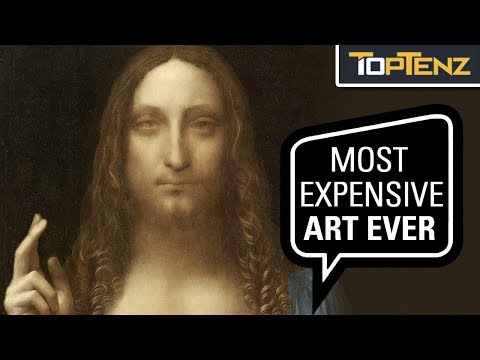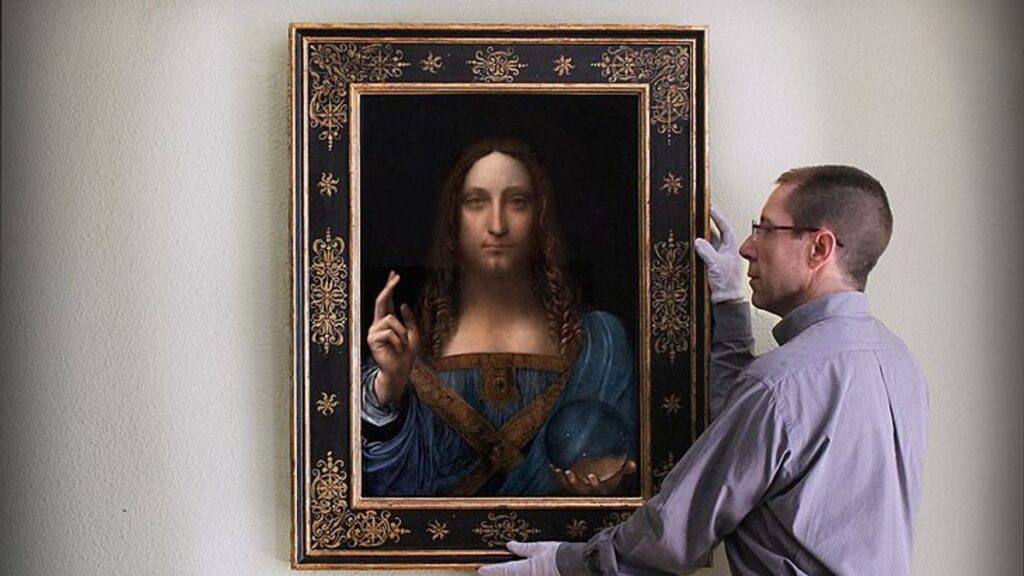
The art world is a fascinating place where a single canvas can become a symbol of immense value. Here, we unveil the top 10 most expensive paintings ever sold, each a masterpiece that transcends artistic merit and enters the realm of high finance and prestige.

The Most Expensive Paintings Ever Sold
- Salvator Mundi (Savior of the World) by Leonardo da Vinci (Estimated 1500): [$450.3 million, sold in 2017] – This enigmatic portrait of Jesus Christ is shrouded in mystery. Once believed to be a copy, it was later attributed to the Renaissance master himself. The painting’s rarity, historical significance, and exquisite detail justify its record-breaking price tag.
- Les Femmes d’Alger (Version ‘O’) (Women of Algiers) by Pablo Picasso (1955): [$179.4 million, sold in 2015] – A vibrant masterpiece by Picasso, depicting a scene inspired by another famous work. The bold colors, distorted figures, and captivating composition solidify Picasso’s place as a artistic giant and the enduring value of his work.
- Interchange by Willem de Kooning (1955): [$300 million, sold in 2015 (private sale)] – A cornerstone of Abstract Expressionism, this large-scale painting explodes with black, white, and yellow. De Kooning’s use of bold strokes and energetic lines challenged traditional notions of form and beauty, making it a coveted piece for collectors.
- Card Players (various versions) by Paul Cézanne (1892-1895): [$250 million, sold in 2011] – A series of paintings by Cézanne, “Card Players” depicts working-class men engrossed in a game. The artist’s focus on geometric shapes and muted colors paved the way for Cubism and solidified his place as a pivotal figure in modern art. The high price reflects the historical significance of this series.
- Nafea Faa Ipoipo (When Will You Marry?) by Paul Gauguin (1892): [$210 million, sold in 2015] – This captivating painting by Gauguin showcases two Tahitian women against a lush green background. The vibrant colors, symbolism, and flattened perspective are hallmarks of Gauguin’s post-Impressionist style. The painting reflects the artist’s fascination with Polynesian culture and his desire to break free from Western art constraints.
- Nu couché (sur le côté gauche) (Reclining Nude) by Amedeo Modigliani (1917): [$186.1 million, sold in 2015] – This Modigliani masterpiece depicts a reclining nude woman in his signature elongated style. The painting’s bold outlines, vibrant colors, and distorted form represent the artist’s unique approach to portraying the human figure.
- Les Demoiselles d’Avignon (The Young Ladies of Avignon) by Pablo Picasso (1907): [$200 million, sold in 2016 (private sale)] – A groundbreaking work by Picasso, this painting depicts five nude female prostitutes in a brothel. The fragmented figures and distorted forms marked a radical departure from traditional art and ushered in Cubism.
- Portrait of Dr. Gachet by Vincent van Gogh (1890): [$163 million, sold in 1990] – This portrait of Dr. Gachet, who treated Van Gogh during his final illness, is a powerful depiction of the doctor. The bold brushstrokes, vibrant colors, and swirling lines are characteristic of Van Gogh’s post-Impressionist style.
- Water Serpents II by Gustav Klimt (1904): [$183.8 million, sold in 2016] – This captivating work by Klimt features his signature use of gold leaf and swirling patterns. The painting depicts a woman with flowing red hair entwined by serpents, showcasing Klimt’s fascination with symbolism and the female form.
- Pendant portraits of Maerten Soolmans and Oopjen Coppit by Rembrandt van Rijn (1634): [$180 million, sold in 2016 (private sale)] – A unique pair of portraits by Rembrandt depicting a married couple. The paintings showcase Rembrandt’s mastery of light, shadow, and detail, solidifying his place as a Dutch Golden Age master.
These ten paintings represent the pinnacle of artistic achievement, historical significance, and market value. They serve as a testament to the enduring power of art to capture our imagination, challenge conventions
How much is Mona Lisa worth?
The Mona Lisa’s worth is a bit tricky to nail down because it’s not for sale. It’s considered priceless due to its cultural and historical significance.
However, we can look at some estimates:
- In 1962, it was insured for $100 million, which translates to roughly $1 billion in 2023 considering inflation.
- Some experts estimate it could be worth much more, possibly exceeding $850 million.
So, while there’s no exact price tag, the Mona Lisa is undoubtedly one of the most valuable paintings in the world. Its true worth goes beyond monetary value.
Why are paintings so expensive?
The art world can be a place of staggering sums, where a single canvas can fetch a price that would make most billionaires blink. But what exactly makes paintings so expensive? This value transcends the cost of materials and artistic labor. Let’s delve into the fascinating interplay of factors that contribute to the astronomical price tags of some paintings.
1. Artistic Merit and Legacy:
At the heart of a painting’s value lies its artistic merit. Great paintings are not mere decorations; they are captivating expressions of human creativity, innovation, and emotion. The technical skill of the artist, the originality of their vision, and the emotional impact of the piece all contribute to its artistic merit.
Furthermore, an artist’s legacy plays a crucial role. Works by masters like Leonardo da Vinci, Vincent van Gogh, or Pablo Picasso are highly sought after because they represent a significant chapter in art history. Owning a piece by such a renowned artist is a way to connect with artistic giants and their enduring influence.
2. Scarcity and Rarity:
The basic economic principle of supply and demand applies to the art world as well. Paintings by deceased artists have a finite supply. The rarer a painting is, especially if it’s part of a small series or by an artist with a limited output, the higher its value becomes. Collectors are willing to pay a premium for exclusivity and the prestige of owning a unique piece.
3. Historical Significance:
Some paintings hold historical significance beyond their artistic merit. They may depict a pivotal moment in history, be associated with a famous person, or represent a major artistic movement. These paintings become valuable historical artifacts, offering a window into the past and fostering a sense of connection with a particular era.
4. Provenance and Ownership History:
The ownership history of a painting can significantly impact its value. A painting that has been owned by other famous collectors or exhibited in prestigious museums gains a certain pedigree and cachet. Knowing that a renowned collector once owned the piece adds to its desirability and perceived value.
5. Investment Potential:
For some, art is not just a passion, but an investment. High-value paintings can be seen as a store of value, particularly in times of economic uncertainty. The hope is that the painting’s value will appreciate over time, offering a significant financial return.
6. Market Forces and Speculation:
The art market itself plays a role in determining a painting’s price. Auction houses and high-profile sales can create a frenzy of bidding, driving prices up beyond a painting’s intrinsic value. Speculation can also inflate prices, as collectors anticipate future appreciation.
7. Emotional Connection and Aesthetics:
While not always quantifiable, the emotional connection a painting evokes in a collector can significantly influence its value. A piece that resonates deeply with a collector, perhaps because of its subject matter, style, or personal connection, may be worth more to them than its market value suggests.
The Intricate Dance of Value:
Understanding why paintings are so expensive requires acknowledging these complex and intertwined factors. Ultimately, a painting’s value is a combination of its artistic merit, historical significance, rarity, market trends, and the emotional connection it evokes. For some, it’s a passion project, for others, an investment, and for many, a captivating window into the human spirit expressed through art.
More Information:
- Most Expensive Gucci Items
- Most Expensive Wines
